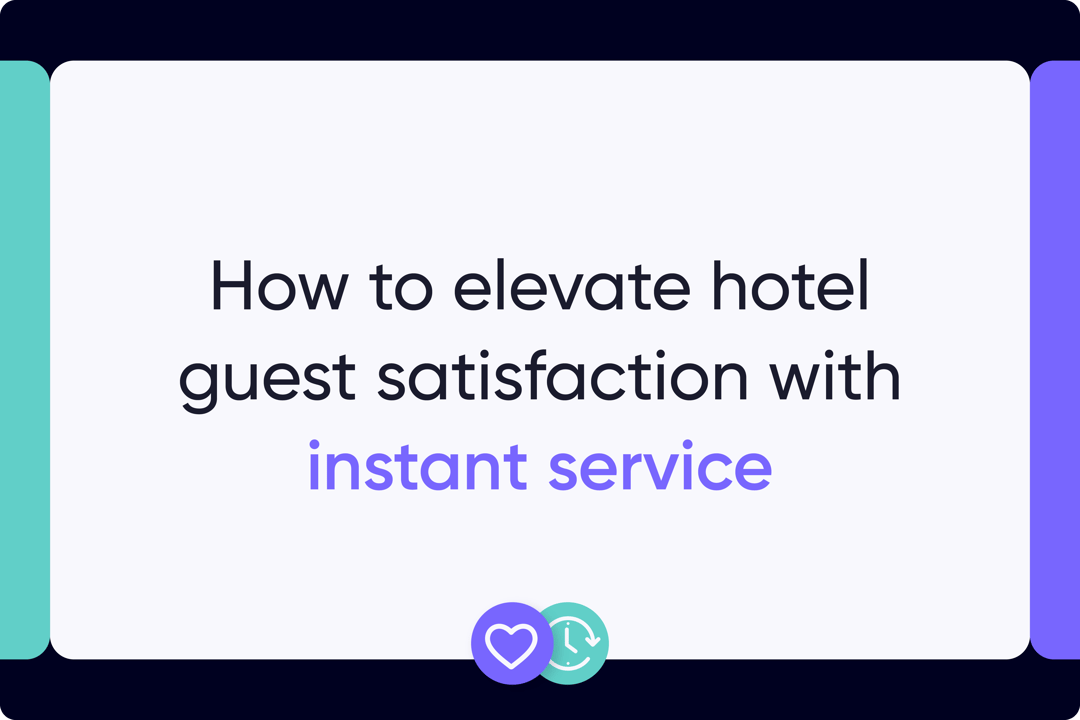We find ourselves in an era where immediacy shapes expectations across various industries, and hospitality is no exception. The desire to respond promptly to our needs and impulses for consumption has become a norm—we want it now, right away. Waiting is not an option.
Delayed responses not only frustrate your customer but also, inevitably, impact the online reputation of your business, particularly in the case of hotels.
For this reason, operations managers, sales teams, and hotel and chain directors of the most prestigious brands have been actively seeking ways to reduce wait times in recent times. This applies to reception, bars and restaurants, rooftops serving F&B, or room service.
Reducing wait times has a domino effect—elevating guest satisfaction, boosting sales volume, and, of course, diminishing queues.
Everything is interconnected.
If your guests don’t have to wait, they will be more satisfied. If your guests are served quickly, sales increase, impacting your hotel's revenue throughout the day. This is the desired scenario for both staff and customers of your resort or hotel—to be attended to instantly.
And what is the secret to approaching this scenario?
In short, it's the optimization of your hotel’s department operations through technology. In other words, what used to take 5 steps from when a guest wants something to when the staff fulfills their request should be reduced by half.
👉 In this post, you will discover:
- How to improve guest satisfaction in your hotel
- Hotel areas in which you can reduce wait times
- 4 steps to boost customer satisfaction and reduce lines
- A pioneer idea to analyze guest’s feedback
Ultimately, you will discover how technology will help your guests feel at home on your property.
Improving guest satisfaction in a hotel by reducing wait times
Almost all experiences in hotels involve guests waiting at some point. Unless the chain or resort has unlimited resources—which is unfeasible, especially in times of crisis to find qualified staff—waiting is a frustration that hotel managers, operations directors, and department heads seek to minimize or avoid for most guests.
Waiting logically compromises the guest's experience, setting off alarm bells. Therefore, it is a constant concern for decision-makers in a hotel.
That's why you've come to the right article—to discover ways to mitigate the effects of overly slow operations.
How can wait times be reduced? Through technology 💡
But first, we need to identify which hotel departments can quickly reduce their wait times.
Hotel departments and areas that can immediately reduce wait times with technology
Reception is the nerve center of a hotel, marking the beginning and end of a guest's stay. It's their first and last impression, and we don't want to fail in this regard. How can we empty the front desk?
Firstly, by defining the services that can only be handled at the front desk.
This post considers the following: we want to offer an outstanding guest experience, and for that, it has to be human. In other words, for a high-end hospitality, where the human factor is crucial, a self check-in kiosk does not seem the most appropriate way to deliver an outstanding personalized service
If the guest is not warmly welcomed, the reduction of wait times will not positively impact the guest experience.
What hotel departments or locations can easily reduce wait times?
- Reception
- Bars and restaurants
- Terraces and rooftops
- Kids clubs
- Spa and sports facilities
- Room Service and Amenities
Reception is the operational hub of a hotel in terms of interaction with guests. It's where check-in (and check-out if not available through the hotel's guest app) takes place.
It's where recommendations are sought, tables and services in the hotel are reserved, spa treatments are booked, or maps are requested—assuming the hotel does not have a guest app.
The spoiler is clear; as we'll see later, a guest app allows guests to request services, access information, or perform various actions, such as reserving a table from their phone, anytime, anywhere—simply and quickly, emptying the front desk.
Bars and restaurants are also sources of frustration if the staff is limited, and guests have to wait to be served. Staff shortages are one of the main concerns for hotel CEOs and operations managers precisely because of this.
However, prestigious chains are reducing wait times, even with this issue, as we'll see later in this article. The same applies to Room Service.
And what about kids clubs? They are also prone to long lines when parents leave their children in the care of hotel staff, as there are forms to fill out, and waiting can be tedious.
But technology has also found a way to streamline the process, eliminate queues, and help the guest avoid waiting, thus improving their perception of your hotel. In this post, we will explain how to enhance your online reputation through technology.
4 steps to boost guest satisfaction and reduce wait times
To explain how to quickly reduce wait times in your hotel, we will offer you ideas and features that will help you understand why leading chains such as Radisson, NH Hotels, Barceló Hotels, Palladium, or Viva Wyndham are achieving smoother operations.
They all have something in common.
They use a guest app from which the guest can:
- Check hotel schedules and information
- View maps and points of interest
- Reserve a table or hammock in the hotel or resort
- Order Room Service or amenities
- Communicate with reception from their smartphone
- Reserve spa or sports facilities
1. Implement a guest app and remove paper
Introducing a guest app not only enhances the guest experience but also streamlines your hotel operations. This innovative solution saves guests’ (and staff’s) valuable time by providing easy access to hotel schedules, information, maps, and points of interest—all conveniently at their fingertips.
Bid farewell to time-consuming phone calls and uncomfortable visits to the reception desk. With all property details, location insights, and services available on your guests' smartphones, lengthy lines will diminish, allowing your reception to prioritize essential matters.
Additionally, this eco-friendly initiative addresses customers' environmental concerns by eliminating up to 1.5 tons of paper usage annually depending on the property’s size.
You'll kill two birds with one stone, adapting to modern systems your guests are accustomed to in their daily lives, and surprising them by offering a paperless stay that aligns with social demands. A win-win.
2. Implement Mobile Ordering in your guest app
In times of staff shortage, no department suffers as much as the bar or restaurant of a hotel. You might be familiar with the image of your staff dealing with the furtive glances of dozens of guests waiting to place their orders.
The staff is overwhelmed, and guests grow tired and frustrated. The same happens when a multitude of customers crowd the doors of one of your restaurants to reserve a table.
That's why solutions like mobile ordering and reservation through the guest app are immediately reducing waiting times. Mobile ordering uses QR codes and NFC technology in bars and rooftops, cutting the ordering process by more than half.
📍It is important to emphasize that these QR codes are location-specific. That is, when a guest scans one on a specific cabana or table to place an order, the system immediately informs the staff of the exact location from which this order has been placed.
This is why the system is so agile and streamlines processes so drastically, allowing for much more efficient service with significantly fewer staff.
Previously, the waiter had to go in person to the guest, take the order, bring it to the kitchen, collect the order, deliver it, and return to request payment. Now, the guest orders and pays from their mobile, without the need for waiters.
The staff only handles receiving the order and delivering it. Waiting times are reduced even in times of staff shortage.
3. Implement a tailor made table manager in your guest app
Similar efficiencies apply to restaurant reservations, where hotels, armed with a tailor made table manager in their guest app, can independently provide guests with restaurant information, while letting them check availability, and reserve tables without direct staff interaction. This control over dining areas enhances staff flexibility and reduces queues.
Ideally, it has to be a table management system tailor-made for hotels to suit the unique operations of a chain or resort and its specific scenarios.
Why? 👀
While there are numerous table management systems available, only a few take into account the complexities of a hotel's dining areas, where guests may include both hotel guests and external visitors.
4. Let your guest fill formularies through his smartphone
The impact of the right guest app in waiting times extends to spa, sports facilities, and Kids clubss, where guest app functionalities eliminate the need for manual form-filling. Parents can now remotely complete forms, streamlining the process, eradicating queues, and elevating guest and staff satisfaction.
There's nothing more frustrating than having to wait during your vacation or after a long day of work to complete a bureaucratic task at the hotel, especially when all your guests know that technology can expedite the process.
It gives a sense of being out of touch with modernity, frustrates, and ultimately diminishes the guest experience, which is precisely what you, as the COO of a chain or hotel operations manager, want to avoid.
Ask your customers and analyze your guests’ feedback
All of this is crucial, and you will enjoy seeing how your hotel, chain, or resort increases its online reputation and guest satisfaction by adopting these tools and technologies.
But remember, asking for feedback is an additional way of checking that everything is going fine.
In fact, 2023 saw the implementation of pioneer instant feedback tools that let hotels ask short questions through their guest apps after pivotal services such as check-in, room service, restaurant, or spa.
You can, of course, keep track of your customer satisfaction, connected to the waiting times too, analyze guest feedback, find new consumption patterns that will also contribute to the goal of personalization, and you will be able to manage guest expectations as well.
Conclusion: Technology's immediate impact on wait times
In conclusion, the seamless integration of technology is not merely a solution to the immediate challenge of minimizing wait times; it serves as a catalyst for a comprehensive enhancement of guest satisfaction.
As industry leaders embrace these innovations, the hotel experience is set to evolve, promising a future where guests feel genuinely at home—unhindered by needless delays or frustrating queues 😉



